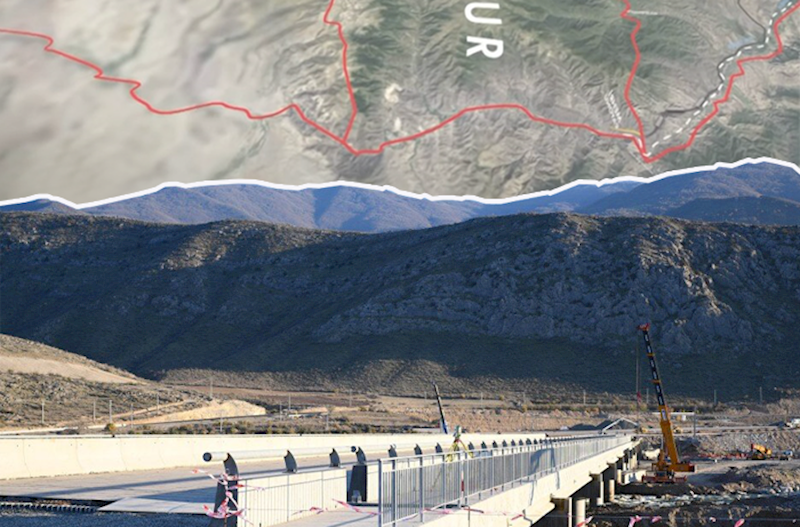
The Agbend-Kelala Bridge, currently under construction on the Iranian-Azerbaijani border across the Araz River, is one of the most strategically important projects for restructuring the regional transportation system and launching a new stage in the geoeconomic dynamics of the South Caucasus. This bridge is more than just a crossing between two countries: it serves as a key geostrategic element of infrastructure located at the intersection of the East-West and North-South transport corridors, strengthening the transit role of both Azerbaijan and Iran.
Its parameters – 216 meters in length, 24.5 meters in width, wide traffic lanes in both directions, and, most importantly, a throughput capacity of up to one thousand trucks per day – clearly show that this is not an ordinary border checkpoint but a future anchor point of the regional transit system.
To fully grasp the significance of this bridge, it is enough to look at the real figures describing Azerbaijan’s current transit role. In 2024 alone, the total volume of goods transported through the country’s transport corridors reached 33 million tons, with transit cargo accounting for roughly half that amount. Transit volume has grown 2.5 times over the past five years, demonstrating Azerbaijan’s rising importance as a transit route. In the first nine months of 2025, 12.6 million tons were transported along the East-West direction and 6.7 million tons along the North-South axis, confirming the already heavy load on existing infrastructure. Against this backdrop, the commissioning of the Agbend-Kelala Bridge will not only logically increase cargo turnover through Azerbaijan but also create a competitive advantage, strengthening the country’s position in the transit market.
From the perspective of integration into the East-West corridor, the bridge plays an important complementary role. Cargo turnover along the China-Central Asia-Caspian Sea-Azerbaijan-Turkey-Europe route (the “Middle Corridor”) increases every year. The majority of goods on this route pass through Azerbaijan, making the opening of new crossings essential for strengthening the corridor. The Agbend-Kelala Bridge will create a multi-channel transit system, reduce reliance on a single crossing point, and provide Azerbaijan with additional flexibility. If the country fails to establish parallel routes of this kind, part of the growing cargo flow may be redirected through alternative pathways in Georgia and Turkey, resulting in a loss of transit revenue.
Within the framework of the North-South corridor, the bridge’s role is even more fundamental. The network connecting Russia, Azerbaijan, and Iran creates the potential for global trade flows of 25-30 million tons per year, and Azerbaijan’s geographic position makes it a natural transit hub. The potential capacity of the Zangezur Corridor is 15 million tons at the initial stage; when combined with Iran’s connection to the Astara-Rasht-Qazvin railway and the commissioning of the Agbend-Kelala Bridge, the competitiveness of the route will increase significantly. The bridge’s capacity – 1,000 trucks per day –means 365,000 vehicles annually, laying the foundation for one of the most powerful road-transport segments in the region.
From an economic standpoint, the bridge will increase both transit revenue and the added value derived from logistics services. Shortened routes will reduce costs for transport companies, making the Azerbaijani route more attractive. In addition, the new crossing will stimulate the development of warehouses, terminals, sorting centers, and other infrastructure, leading to the creation of thousands of jobs and hundreds of millions of dollars in additional economic activity. Growth in cargo flow along the corridor means not only increased transit fees but also higher earnings at every stage of the logistics chain.
From a political and strategic perspective, the bridge will help restore trust in relations between Azerbaijan and Iran and create a platform for secure, infrastructure-based cooperation. For Azerbaijan, the project enhances the economic value of Eastern Zangezur and establishes a safer and more sustainable connection with Nakhchivan. For Iran, the bridge opens an alternative transit route into the Eurasian space, strengthens the country’s geoeconomic influence in the region, and creates new trade opportunities. Strengthening regional transport links also contributes to political stability, as increased economic integration reduces political risks.
All these factors show that the Agbend-Kelala Bridge is not merely a border crossing but a key component of a new stage in Azerbaijan’s regional transport architecture. If the infrastructure is commissioned on time and customs procedures are harmonized, the bridge could reshape the transit map of the South Caucasus. Otherwise, if the project is delayed or its potential remains underutilized, Azerbaijan’s position in the transit competition may weaken.

Allahverdi Jafarov

 Tətbiqimizi yükləyə bilərsiniz
Tətbiqimizi yükləyə bilərsiniz

